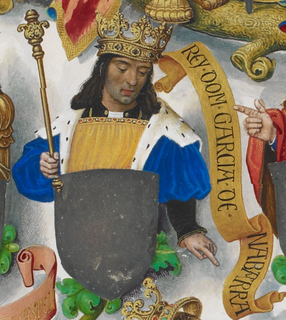The County of Monzón was a marcher county of the Kingdom of León in the tenth and eleventh centuries, during a period of renewed external threat (the Caliphate of Córdoba) and disintegration of royal authority. The county was created by Ramiro II for Ansur Fernández in 943 and was ruled by his descendants, the Banu Ansur (Banu Anshur) or Ansúrez, for decades. The seat of the county was initially at the castle of Curiel and later at Monteson; to its east the river Pisuerga served as a border with the County of Castile. The County of Monzón straddled both banks of the Duero: south of the river its territories comprised Peñafiel or Sacramenia, north of the river it extended to the Cantabrian Mountains and included the populations of Redondos, Mudá, Rueda de Pisuerga, and Salinas de Pisuerga. [1]
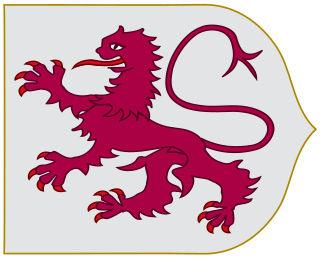
The Kingdom of León was an independent kingdom situated in the northwest region of the Iberian Peninsula. It was founded in AD 910 when the Christian princes of Asturias along the northern coast of the peninsula shifted their capital from Oviedo to the city of León. The County of Castile separated in 931, the County of Portugal separated to become the independent Kingdom of Portugal in 1139 and the eastern, inland part of León was joined to the Kingdom of Castile in 1230.
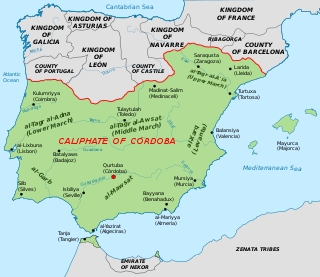
The Caliphate of Córdoba was a state in Islamic Iberia along with a part of North Africa ruled by the Umayyad dynasty. The state, with the capital in Córdoba, existed from 929 to 1031. The region was formerly dominated by the Umayyad Emirate of Córdoba (756–929). The period was characterized by an expansion of trade and culture, and saw the construction of masterpieces of al-Andalus architecture. In January 929, Abd ar-Rahman III proclaimed himself Caliph of Córdoba, replacing thus his original title of Emir of Córdoba. He was a member of the Umayyad dynasty, which had held the title of Emir of Córdoba since 756.
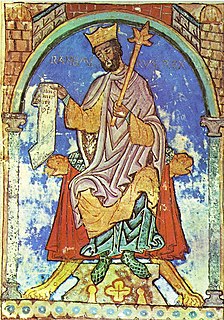
Ramiro II, son of Ordoño II, was a King of León from 931 until his death. Initially titular king only of a lesser part of the kingdom, he gained the crown of León after supplanting his brother Alfonso IV and cousin Alfonso Fróilaz in 931. The scant Anales castellanos primeros are a primary source for his reign.
Contents
Ansur's successor as count was his son Fernando, who had five brothers. All five appear to have predeceased him and when he died he had no sons. His successor was his sister, Teresa Ansúrez, and, through her, her son, king Ramiro III of León. The king immediately travelled to Santa María de Fusiellos, the chief religious centre of the county, and endowed it with the villages of San Julián and Abandella in order to secure local support (and for the good of his soul). [2] Fernando's widow, Toda, was allowed to retain the title cometissa (countess) and govern the city of Dueñas, which was part of Monzón. [3]
Fernando Ansúrez II was the Count of Monzón, Peñafiel, and Campos from 950 and one of the most powerful noblemen of his generation in the Kingdom of León. He was the eldest son of Ansur Fernández and namesake of his grandfather, Fernando Ansúrez I. His sister Teresa was the queen of Sancho I and later regent for her son, Ramiro III.

Teresa Ansúrez was the Queen consort of King Sancho I of León, and because of that, she is also known as Teresa of Leon. She was regent of her son in 975-979.

Ramiro III, king of León (966–984), was the son of Sancho the Fat and his successor at the age of only five.
The county disappears from contemporary records during its attachment to the crown, and it appears to have been incorporated into Castile after the tumultuous succession of Vermudo II in 985. The Castilian count García Fernández made a donation of the village of Santiago del Val in the county of Monzón to the monastery of San Isidro de Dueñas in the same county, indicating both his ability to dispose of Monzón's lands and his patronage of the church in Monzón. A charter of San Isidro for the year 990 refers to the king and the count of Castile, but not to any count of Monzón. The first sure indication that the Castilians were in control of Monzón comes from a document of Sancho III of Pamplona, which describes how he came to control Castile and Monzón. It notes that Sancho García possedit ... Castella et Monteson (possessed Castile and Monzón) "after Fernando [Ansúrez]", though the document does not mention any intervening rulers. [4] After Sancho García's death (1017), the king of Navarre, with his mother, Jimena Fernández, and the new count of Castile, García Sánchez, with his mother, Urraca, came together to confirm the privileges of Monzón and Dueñas at Husillos for the benefit of the late count's soul. (Sancho of Pamplona was married to Muniadona, García Sánchez's sister.) Monzón remained with the county of Castile until 1038, when the count of Castile, Fernando Sánchez, became king. The boundaries of the later Kingdom of Castile included the old county of Monzón. In 1067 Sancho II of Castile made the monastery of Santa María de Mamblas south of the Duero a daughter house of Santo Domingo de Silos. It is probable that Mamblas represents the southwest extremity of the county of Monzón as inherited by Sancho García. [5]
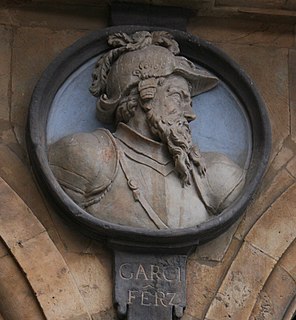
García Fernández, called of the White Hands, was the count of Castile and Alava from 970 to 995. In May 995, he was captured by a raiding party while out hunting. Wounded in the encounter, he was sent to Cordoba as a trophy, but died at Medinaceli in June 995.

Sancho Garcés III, also known as Sancho the Great, was the King of Pamplona from 1004 until his death in 1035. He also ruled the County of Aragon and by marriage the counties of Castile, Álava and Monzón. He later added the counties of Sobrarbe (1015), Ribagoza (1018) and Cea (1030), and would intervene in the Kingdom of León, taking its eponymous capital city in 1034.
Sancho García, called of the Good Laws, was the count of Castile and Álava from 995 to his death.
Historian Justo Pérez de Urbel's argument that in 985 Monzón was annexed by the Banu Gómez clan that ruled Saldaña and Carrión was based on a document of 995 that names them as the only rulers between Zamora and Castile, without specifying the boundaries of the latter. The fourteenth-century historian Ibn Khaldun also thought Monzón to have been a territory of the Banu Gómez, but his witness is too late to be of independent value. [6]
Justo Pérez Santiago later known as Fray Justo Pérez de Urbel y Santiago O.S.B. was a Spanish Roman Catholic clergyman and medievalist, first abbot of the Monastery of the Holy Cross of the Valle de los Caídos, member of the Consejo Nacional del Movimiento, later a Procurador en Cortes and distinguished scholar of medieval Castile.
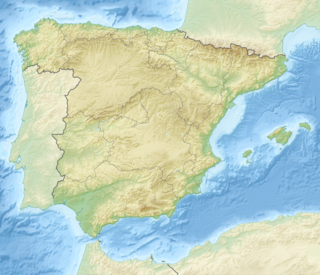
The Banu Gómez were a powerful but fractious noble family living on the Castilian marches of the Kingdom of León from the 10th to the 12th centuries. They rose to prominence in the 10th century as counts in Saldaña, Carrión and Liébana, and reached their apogee when, allied with Córdoba warlord, Almanzor, their head, García Gómez, expelled king Vermudo II of León and briefly ruled there. He would reconcile with the royal family, but launched two subsequent rebellions. On his death, the senior line of the family was eclipsed, but a younger branch would return to prominence, producing Pedro Ansúrez, one of the premier noblemen under king Alfonso VI and queen Urraca in the late 11th and early 12th centuries. The family would be portrayed in the Cantar de Mio Cid as rivals and antagonists of the hero, El Cid, and their rebellions would serve as a basis for the legend of Bernardo del Carpio.
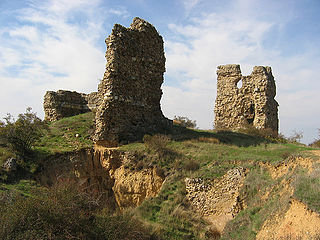
Saldaña is the principal town of the fertile Palencia plains in Spain, and may be the town of "Eldana" mentioned by the historian Ptolemy as being conquered by the Roman Empire.




